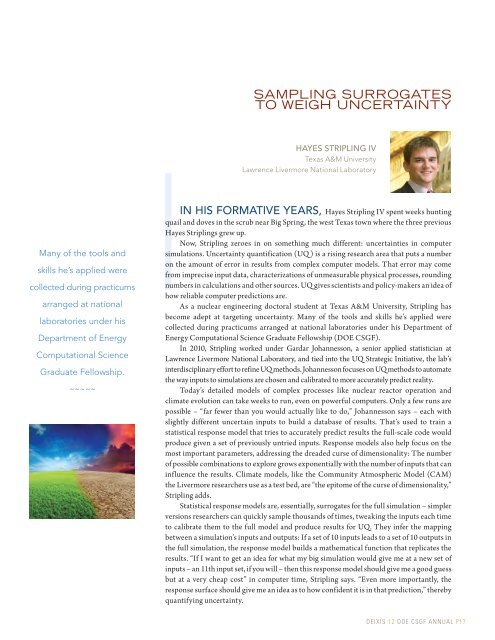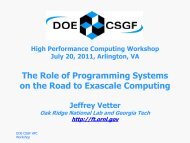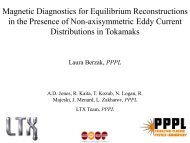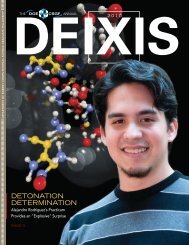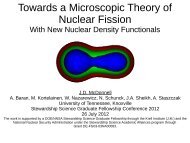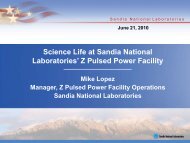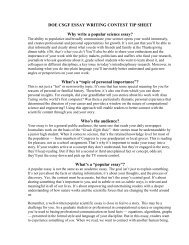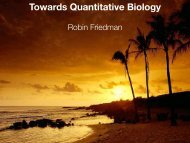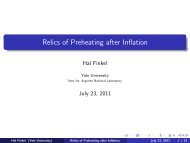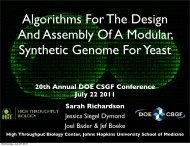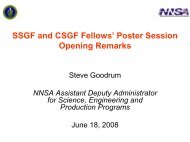2012 - Krell Institute
2012 - Krell Institute
2012 - Krell Institute
Create successful ePaper yourself
Turn your PDF publications into a flip-book with our unique Google optimized e-Paper software.
SAMPLING SURROGATES<br />
TO WEIGH UNCERTAINTY<br />
Many of the tools and<br />
skills he’s applied were<br />
collected during practicums<br />
arranged at national<br />
laboratories under his<br />
Department of Energy<br />
Computational Science<br />
Graduate Fellowship.<br />
~~~~~<br />
I<br />
HAYES STRIPLING IV<br />
Texas A&M University<br />
Lawrence Livermore National Laboratory<br />
IN HIS FORMATIVE YEARS, Hayes Stripling IV spent weeks hunting<br />
quail and doves in the scrub near Big Spring, the west Texas town where the three previous<br />
Hayes Striplings grew up.<br />
Now, Stripling zeroes in on something much different: uncertainties in computer<br />
simulations. Uncertainty quantification (UQ ) is a rising research area that puts a number<br />
on the amount of error in results from complex computer models. That error may come<br />
from imprecise input data, characterizations of unmeasurable physical processes, rounding<br />
numbers in calculations and other sources. UQ gives scientists and policy-makers an idea of<br />
how reliable computer predictions are.<br />
As a nuclear engineering doctoral student at Texas A&M University, Stripling has<br />
become adept at targeting uncertainty. Many of the tools and skills he’s applied were<br />
collected during practicums arranged at national laboratories under his Department of<br />
Energy Computational Science Graduate Fellowship (DOE CSGF).<br />
In 2010, Stripling worked under Gardar Johannesson, a senior applied statistician at<br />
Lawrence Livermore National Laboratory, and tied into the UQ Strategic Initiative, the lab’s<br />
interdisciplinary effort to refine UQ methods. Johannesson focuses on UQ methods to automate<br />
the way inputs to simulations are chosen and calibrated to more accurately predict reality.<br />
Today’s detailed models of complex processes like nuclear reactor operation and<br />
climate evolution can take weeks to run, even on powerful computers. Only a few runs are<br />
possible – “far fewer than you would actually like to do,” Johannesson says – each with<br />
slightly different uncertain inputs to build a database of results. That’s used to train a<br />
statistical response model that tries to accurately predict results the full-scale code would<br />
produce given a set of previously untried inputs. Response models also help focus on the<br />
most important parameters, addressing the dreaded curse of dimensionality: The number<br />
of possible combinations to explore grows exponentially with the number of inputs that can<br />
influence the results. Climate models, like the Community Atmospheric Model (CAM)<br />
the Livermore researchers use as a test bed, are “the epitome of the curse of dimensionality,”<br />
Stripling adds.<br />
Statistical response models are, essentially, surrogates for the full simulation – simpler<br />
versions researchers can quickly sample thousands of times, tweaking the inputs each time<br />
to calibrate them to the full model and produce results for UQ. They infer the mapping<br />
between a simulation’s inputs and outputs: If a set of 10 inputs leads to a set of 10 outputs in<br />
the full simulation, the response model builds a mathematical function that replicates the<br />
results. “If I want to get an idea for what my big simulation would give me at a new set of<br />
inputs – an 11th input set, if you will – then this response model should give me a good guess<br />
but at a very cheap cost” in computer time, Stripling says. “Even more importantly, the<br />
response surface should give me an idea as to how confident it is in that prediction,” thereby<br />
quantifying uncertainty.<br />
DEIXIS 12 DOE CSGF ANNUAL P17


